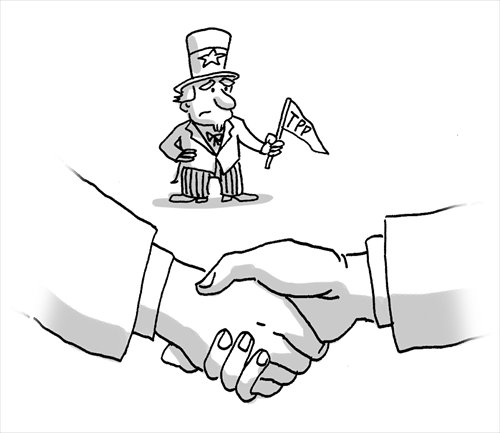HOME >> OP-ED
Long-delayed agreement puts Australia ahead of the game
By Geoff Raby Source:Global Times Published: 2015-6-22 20:38:03

Illustration: Liu Rui/GT
Wednesday's formal signing of the China-Australia Free Trade Agreement (ChAFTA) brought to a close a process that begun more than a decade ago.
In 2003, Australia had just concluded a major bilateral free trade agreement with the US. Senior trade officials in Canberra believed that it should be balanced by one with China.
By 2003, Australia's economy was quite open, and on the surface there did not seem to be much on offer in such an agreement for China. It was hoped, however, that China would, firstly, see this as a geopolitical strategic opportunity to balance the US and, secondly, use such an agreement with a relatively big developed country to bring more of its industries up to world levels of competitiveness, especially in the services sector.
Australia was the first developed country to approach China about negotiating a bilateral free trade agreement. China had not been contemplating FTAs at that time as it was still digesting its WTO accession, which was controversial in China.
After nearly two years of discussions, and the negotiation of a Trade and Investment Framework Agreement, which had buried within it an agreement to commence negotiations on a FTA, China was prepared to start negotiations. The price: Australia had to agree in advance to grant China "market economy status" in the WTO.
Market economy status was highly prized by China's trade officials at the time. It was seen as conferring status and legitimacy on China as a full WTO member, it would constrain the use of anti-dumping measures against it, and tactically if Australia yielded it would put considerable pressure on both the US and EU to do the same. In private, both were distinctly unhappy with Australia when it eventually conceded market economy status to China.
Although a purely technical issue within the WTO's Anti-dumping and Countervailing Duties Agreement, it became a highly politically contentious issue within Australia before negotiations commenced. In response, the Australian government began to wobble in its commitment to commencing negotiations.
This in turn shaped Australia's initial approach to the negotiations, which over time became entrenched as dogma. Australia set unrealistically high levels of ambition. The FTA had to be "fully liberalizing, comprehensive and WTO plus."
Consequently, negotiations dragged on for a decade. It was not until the election of the Abbott government in 2012 and the appointment of a new trade minister, Andrew Robb, that a pragmatic approach was adopted on the Australian side. By that time, some of Australia's direct competitors in agriculture, such as New Zealand and Chile, had long concluded their FTAs with China.
Robb made a clear decision that he would cut a deal. Some areas, such as sugar and tariff-rate quotas on some agricultural products, would be set aside for the future in order to secure a deal now. This proved to be the decisive breakthrough.
At the same time, China's own economic agenda was changing following the Third Plenum of the 18th CPC Central Committee in October 2013. Recognizing the level of development that China was approaching and the consequent need to adjust China's economic growth model, policy shifted to emphasize the "decisive role" of the market, the importance of the private sector and a degree of urgency to reform the financial sector, open capital accounts further, internationalize the RMB, and encourage foreign participation in the services sector. In many ways, ChAFTA has achieved the objectives that were first envisaged for it.
It is a high-quality agreement, notwithstanding the pragmatism that enabled negotiations to reach a conclusion. For Australia, it will, over the course of its implementation, restore a level playing field with its competitors. For China, the substantial outcomes in the services sector, while of benefit to Australia, will assist China greatly with its next stage of economic reform. China's services sector can only benefit from greater competition with Australian firms.
ChAFTA is still the first bilateral FTA China has signed with a major developed country. For Australia, it now has FTAs with the world's two great powers. To date, no other major country can claim to have done that.
The author is former Australian ambassador to China, and now chairman of Geoff Raby & Associates, a Beijing-based advisory firm. opinion@globaltimes.com.cn
Posted in: Viewpoint